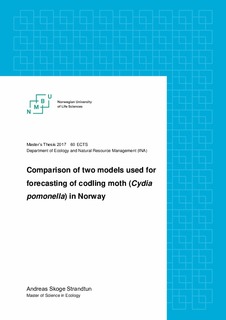| dc.description.abstract | The codling moth (Cydia pomonella L.) is a problematic pest across the world, as well as in the eastern parts of Norway. The adult emerges in mid to late spring, after having overwintered as a fifth instar larvae, and the females begin to lay eggs a few days after. The larva damages crops in apple orchards by digging into the fruit and eating the seeds. In pest management it is critical to target the larvae before it can enter the fruit. Two forecasting models are used to find the oviposition and hatching timing in Norway: the traditional model and RIMpro-Cydia. The plum fruit moth (C. funebrana) is a smaller relative of the codling moth, and has been reported to have a similar phenology, but has no warning system in place for alerting growers. The aim of this study was to test how good these two models are for forecasting attacks of Cydia pomonella in Norwegian apple orchards, in order to improve pest management for growers.
Fieldwork was conducted in apple orchards in eastern Norway. The flight period was monitored using sex pheromone baited delta traps, placed in each of the orchards. Larvae feeding inside of apples were collected, and measurements of the width of their head capsules were used to estimate the time of oviposition and hatching, and compared with the output from the traditional model and RIMpro. Damage from codling moth larvae was recorded at harvest to examine the relationship with pheromone trap catches. The flight period of C. funebrana was also monitored, in order to compare with the flight period of codling moth, from both pheromone traps and the forecast from RIMpro.
RIMpro was found to give a good simulation of the codling moth flight period, given that the delay between male and female emergence is taken into account and that the orchard has a large population of codling moth. When compared to estimations made from collected larvae, the traditional model and RIMpro appear to be equally competent at forecasting the start of oviposition, while which model best predicted the start of hatching varied with orchard. A moderate correlation was found between codling moth catches and the damage found at harvest, but because of the low percentage of damage found, this might not be reliable. Comparing trap data of C. funebrana with trap data of C. pomonella and the RIMpro simulation shows the two species have similar flight activity in the first month after adult emergence. | nb_NO |
